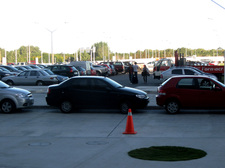 Each morning during the week I drive my son to school. It’s just a routine we started this year because I wanted him to be able to sleep in, and not have to be on a bus for an hour before arriving at school. So, we drive. There are two ways you can drop your student off. The front – park, and ensure your student walks across the throughways to the safe side of the sidewalk. Or, the back – drive up to the sidewalk, open the door and your student pops out. We opt for the back drop-off. It’s easier, even though it’s a longer walk to the locker in the morning. (He can handle it!) At the beginning of the school year, a staff member volunteers to stand outside in back to assist all the new parents (like me) by ensuring they drive up as far as possible in a line next to the sidewalk to ensure the maximum amount of drop-offs can happen simultaneously. We have around 1200 students in school, and if even 1/3 of those are dropped off, you can imagine the number of cars that can line up in the morning. The volunteer even has a sign that says (I’m probably paraphrasing a bit here) “Pull Forward To This Spot” and there may even be an arrow there, too. In the beginning of the school year, there are also cones put out, just to make sure everyone is very aware of what’s going on. So, you’d figure that by December, we should all be pros about this. Pull all the way forward as much as you can. Student hops out. You leave. Simple. But something happened over the course of time. The volunteer stopped standing out there. (I don’t blame her, either. It was FREEZING!) But she shouldn’t have to. She taught us well. But as soon as she stopped standing out there, people stopped following the routine. Rather than pull up all the way to allow as many cars as possible to drop their students off, people would stop right in front of the entry doors (leaving at least three to four car lengths of drop-off space ahead of them). And as more and more people did this, the waiting line got longer and longer. My son and I were fascinated when it first started happening, because we didn’t know why. Were we arriving later than usual? Were more people dropping off on a Tuesday than a Monday? But it didn’t matter which day, and we were there at generally the same time each day. So we started to look around. And we noticed that people weren’t pulling up where they were supposed to, causing a line of cars that would just keep building up and building up. So, why am I telling you this seemingly unimportant (and perhaps boring) story? Because it’s a great example of how important it is to do some of the little things we do, and when we don’t do them, things falter. Things fail. If you walk into a business and the worker doesn’t say “hello” or “thank you” – aren’t you a bit miffed? Don’t you feel like they’re a bit rude? If your waitress doesn’t bring you a glass of water, do you give her less of a tip? Think of it this way. You go to Starbucks, through the drive-thru, and you ask for a Venti bold with cream and sugar. You get your coffee, and you go merrily on your way. As soon as you take a sip, something’s wrong. No sugar! Now you’re peeved. And maybe your “peeveness” (yeah, it’s not a word) gets taken to the next person you meet. You’re a little extra gruff because of lack of sugar. You snap at them. And they go back to their desk and they’re peeved now. And they get a call from a customer, and they send some of their “peeveness” (still not a word!) to the customer. And then the customer is peeved. And that is no good for your business. My point is, these little things that we do are important, and they affect us, and they affect others. It can turn into a big snowball and make a lot of people unnecessarily peeved. Little things mean a lot. Save the world some “peeveness.” :)
0 Comments
|
Author28+ years of business experience. 15+ years of virtual experience. topics
All
Archives
May 2020
|
 RSS Feed
RSS Feed